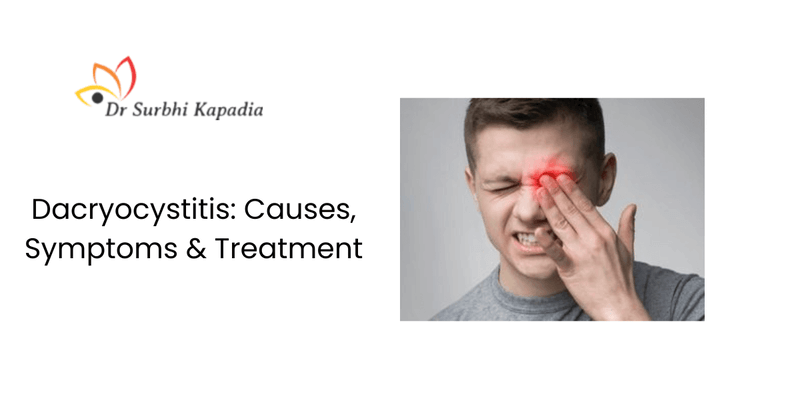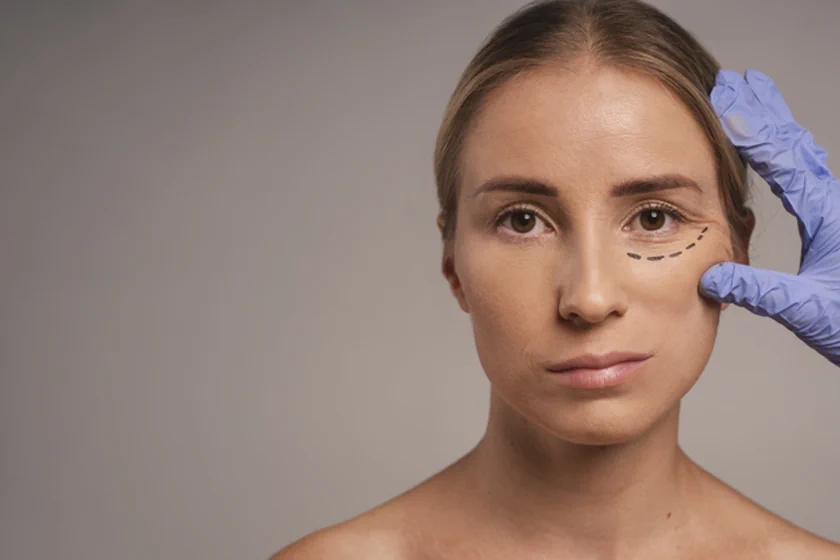|
Getting your Trinity Audio player ready...
|
What Causes Dacryocystitis?
Dacryocystitis is an inflammation of the lacrimal sac, primarily caused by a blockage in the nasolacrimal duct. This blockage prevents tears from draining normally, leading to infection and inflammation. Several factors can contribute to this condition, making it essential for patients to seek a precise diagnosis and appropriate treatment from the best eye hospital in Vadodara to manage the symptoms effectively.
Common Causes of Dacryocystitis
Sinus Inflammation and Nasal Conditions: Inflammation of the sinuses, often due to chronic sinusitis, can extend into the nasolacrimal duct. This inflammation can lead to narrowing or blockage, precipitating acute and chronic dacryocystitis. Nasal polyps or tumours can also exert pressure on the duct, impeding tear flow.
Facial Trauma: Injury to the face, particularly around the nose or eyes, can cause immediate or delayed blockage of the tear drainage system. Such injuries might lead to acute cases if infection occurs, necessitating rapid acute dacryocystitis treatment.
Post-Surgical Complications: Procedures involving the nasal passages, sinuses, or the lacrimal system can sometimes lead to dacryocystitis as a complication. For example, the scarring or inadvertent damage during sinus surgery might obstruct the tear ducts, promoting infection.
Foreign Particles and Infections: Foreign particles or chronic infections within the nasal cavity can occasionally lead to tear duct blockage. Chronic infections are particularly significant as they can cause lasting inflammation that narrows the duct, contributing to chronic dacryocystitis.
Common Symptoms of Dacryocystitis
Redness and Pain: One of the most noticeable symptoms of dacryocystitis is redness around the eyes, particularly near the inner corner next to the nose. This area may also feel tender or painful to the touch, often signalling an infection or inflammation of the lacrimal sac.
Swelling: Swelling in the same area is another critical symptom. The inflammation can cause noticeable puffiness, which might be tender and sometimes extend down the side of the nose.
Watery Eyes: Excessive tearing or watery eyes occur because the blockage in the tear duct prevents tears from draining normally. This symptom indicates chronic dacryocystitis, where the tear duct remains blocked for an extended period.
Fever and General Malaise: In cases of acute dacryocystitis, the patient might experience a fever and a general feeling of being unwell. These systemic symptoms suggest that the body is fighting an infection.
Additional Symptoms
Purulent Discharge: Patients with acute dacryocystitis may notice a thick, yellow or green discharge from the eye, particularly upon pressing the area near the inner corner of the eye. This pus-like discharge indicates an infection that may require immediate medical attention.
Blurred Vision: In severe cases, the swelling and infection can affect the patient’s vision, leading to blurriness. This symptom should not be ignored, as it can signify the spread of infection or greater inflammation.
Sensitivity to Light: A heightened sensitivity to light, or photophobia, can occur if the inflammation is near the cornea or significant swelling.
Diagnosis and Treatment
Dacryocystitis Diagnosis: Diagnosing dacryocystitis typically involves a thorough examination by an eye specialist, who may perform tests such as dacryocystography, where a dye is used to visualise tear flow and blockage. Imaging studies, including CT scans, might also be employed to identify the extent of the obstruction and inflammation.
Dacryocystitis Treatment: Treatment varies depending on whether dacryocystitis is acute or chronic. Acute dacryocystitis treatment usually involves antibiotics to combat infection, sometimes administered intravenously for severe infections. Chronic dacryocystitis might require surgical intervention, such as dacryocystorhinostomy, where a new tear drainage pathway is created to bypass the blocked duct.
In Vadodara, patients can consult with renowned specialists at the best eye hospitals for tailored treatment plans. Dr. Surbhi Kapadia, one of the best eye specialists in Vadodara, offers comprehensive treatment options for both acute and chronic dacryocystitis, utilising the latest diagnostic techniques and treatments to ensure the best care and outcomes.
Statistical Data on Dacryocystitis
Dacryocystitis, an inflammation of the lacrimal sac often due to obstruction of the nasolacrimal duct, affects a significant portion of the population. Research indicates that acute dacryocystitis is more prevalent among infants due to congenital blockages, whereas chronic dacryocystitis frequently affects adults, especially women over the age of 40. Statistics show that approximately 5% of newborns exhibit some nasolacrimal duct obstruction, although only a small percentage develop acute dacryocystitis. Among adults, chronic dacryocystitis occurs in roughly 20 per 100,000 annually, highlighting the importance of recognizing early symptoms and seeking prompt treatment.
Case Study: Successful Treatment of Chronic Dacryocystitis
Case Background: Mrs. Geeta, a 52-year-old resident of Vadodara, had been experiencing persistent tearing and recurrent eye infections for several months. She noticed swelling and tenderness around her left nasal bridge and occasionally saw pus discharge from the corner of her eye. Concerned about her worsening symptoms, she consulted Dr. Surbhi Kapadia at the best eye hospital in Vadodara.
Diagnostic Approach: Dr. Surbhi performed a thorough examination using dacryocystography, which confirmed a blockage in Mrs. Geeta’s nasolacrimal duct. Given her symptoms and the chronic nature of her condition, Dr. Surbhi diagnosed her with chronic dacryocystitis.
Treatment Strategy: Dr. Surbhi recommended a dacryocystorhinostomy (DCR), a surgical procedure designed to create a new drainage pathway for the tears directly into the nasal cavity, bypassing the blocked duct. The surgery was meticulously planned and executed, considering Mrs. Geeta’s medical history and specific anatomical considerations.
Outcome: The surgery was a success, with Mrs. Geeta experiencing significant relief from her symptoms. Post-operative care included antibiotics and steroid eye drops to prevent infection and manage inflammation. At her follow-up visits, Mrs. Geeta reported a marked improvement in her quality of life, with no recurrence of symptoms.
Conclusion: This case highlights the effectiveness of timely, expert intervention in managing chronic dacryocystitis, particularly when performed by a specialist like Dr. Surbhi Kapadia, the best eye doctor in Vadodara. Patients benefiting from such specialised care are a testament to the high standards of treatment provided at the best eye hospital in Vadodara.
Frequently Asked Questions (FAQs) About Dacryocystitis and Dacryoadenitis
What is the best antibiotic for dacryocystitis?
The best antibiotic for dacryocystitis often includes broad-spectrum antibiotics such as amoxicillin-clavulanate or a combination of cephalexin and metronidazole, particularly when treating acute cases. However, antibiotic selection can vary based on the patient's circumstances and microbial culture results.
What medication is used for Dacryoadenitis?
Treatment for dacryoadenitis, a lacrimal gland inflammation, may involve antibiotics if a bacterial infection is suspected or corticosteroids to reduce inflammation in non-infectious cases.
What are the three stages of dacryocystitis?
The three stages of dacryocystitis include:
-
- Acute: Rapid onset of symptoms such as pain, redness, and swelling.
- Subacute: Less severe symptoms that may not resolve completely.
- Chronic: Ongoing inflammation with intermittent flare-ups and persistent symptoms.
What drug is used for dacryocystitis?
The drugs commonly used for dacryocystitis include antibiotics to treat the underlying infection and sometimes anti-inflammatory medications to reduce swelling and discomfort.
What is the treatment of choice for dacryocystitis?
The treatment of choice for dacryocystitis generally involves antibiotic therapy to fight infection. In chronic cases, dacryocystorhinostomy may be performed to restore proper tear drainage.
What oral antibiotics treat dacryoadenitis?
Depending on the suspected or cultured pathogen, oral antibiotics such as doxycycline or amoxicillin can be effective in treating bacterial dacryoadenitis.
What corticosteroids are used for dacryoadenitis?
Corticosteroids like prednisone may reduce severe inflammation in dacryoadenitis, particularly in cases not caused by bacterial infection.
What is the agent of dacryocystitis?
Dacryocystitis is typically caused by bacterial infection, with common agents including Staphylococcus aureus, Streptococcus pneumoniae, and Haemophilus influenzae.
How do you treat acute dacryocystitis at home?
Home treatment for acute dacryocystitis can include applying warm compresses to the affected area several times a day to help relieve pain and promote drainage. However, it is important to consult a healthcare provider for appropriate medical treatment to avoid complications.
Follow our YouTube Channel
![]()








